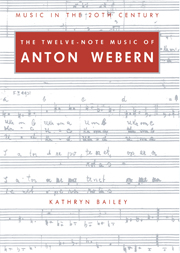Book contents
- Frontmatter
- Contents
- Acknowledgements
- Conventions in the text
- Introduction
- PART I Row and canon
- PART II The instrumental music
- Introduction to Part II
- 4 The movements in sonata form: Opp. 20/ii, 21/i, 22/i, 24/i and 27/i
- 5 The movements in variation form: Opp. 21/ii, 24/iii, 27/iii, 28/i and 30
- 6 The movements in rondo and ternary forms: Opp. 20/i, 22/ii, 24/ii, 28/ii and 28/iii
- 7 The movement in binary form: Op. 27/ii
- PART III The music with voices
- Conclusion
- Appendices
- Notes
- Glossary
- Chronological worklist
- Select bibliography
- Index
4 - The movements in sonata form: Opp. 20/ii, 21/i, 22/i, 24/i and 27/i
Published online by Cambridge University Press: 23 December 2009
- Frontmatter
- Contents
- Acknowledgements
- Conventions in the text
- Introduction
- PART I Row and canon
- PART II The instrumental music
- Introduction to Part II
- 4 The movements in sonata form: Opp. 20/ii, 21/i, 22/i, 24/i and 27/i
- 5 The movements in variation form: Opp. 21/ii, 24/iii, 27/iii, 28/i and 30
- 6 The movements in rondo and ternary forms: Opp. 20/i, 22/ii, 24/ii, 28/ii and 28/iii
- 7 The movement in binary form: Op. 27/ii
- PART III The music with voices
- Conclusion
- Appendices
- Notes
- Glossary
- Chronological worklist
- Select bibliography
- Index
Summary
Sonata occupies a position of particular pre–eminence in Western music as an acknowledged vehicle for the expression of lofty ideas. In Fundamentals of Musical Composition Schoenberg cites as the greatest merit of sonata form, ‘which enabled it to hold a commanding position over a period of 150 years’, its ‘extraordinary flexibility in accommodating the widest variety of musical ideas, long or short, many or few, active or passive, in almost any combination’. As regarded by the nineteenth century, the sonata is the most inherently dramatic of the homophonic forms: reduced to its essentials, the romantic sonata represents an unfolding series of events and relationships between two protagonists of contrasting keys and character. To a considerable extent these events and relationships are stylized. Typically the first theme or group is dramatic and the second lyrical; the first is always in the tonic key (or at least begins and ends there) and the second never is; the themes are stated in succession at the beginning, prior to the section where the drama takes place, and again at the end, after it is completed, where the results of the confrontation may be seen in several ways, but most reliably in the second theme's capitulation and acceptance of the key of the first as its own; the drama is effected in the central section through the fragmentation of the themes and possibly their combination or reconstitution, perhaps imitation or inversion, without exception sequence and modulation. This was the view of sonata form current at the beginning of the century and the one Webern would have learned as a student.
- Type
- Chapter
- Information
- The Twelve-Note Music of Anton WebernOld Forms in a New Language, pp. 153 - 194Publisher: Cambridge University PressPrint publication year: 1991



